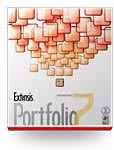
| Home |
| Join/Renew Online! |
| About NCMUG |
| Membership |
| Newsletter |
| Special Interest Groups |
| Mail Lists |
| Volunteering |
| Book Library |
| Member Sites |
| NCMUG FAQs |
| Mac FAQs |
| Contact Us |
| Site Map |

 Portfolio
7: Multi-Media Management Tool
Portfolio
7: Multi-Media Management Tool
Review by NCMUG member John Monteschio
 Portfolio 7 is really just part of a suite of products Extensis offers
for what they call "Enterprise Content Management" (or ECM.)
In a nutshell, ECM is the concept of organizing a large database of multi-media
content so that it can be shared and searched across multiple users.
But by making the client part of this product line available as a separate
entity, Extensis has made some of the power of Portfolio 7 available
even to individual users.
Portfolio 7 is really just part of a suite of products Extensis offers
for what they call "Enterprise Content Management" (or ECM.)
In a nutshell, ECM is the concept of organizing a large database of multi-media
content so that it can be shared and searched across multiple users.
But by making the client part of this product line available as a separate
entity, Extensis has made some of the power of Portfolio 7 available
even to individual users.
Although Portfolio can handle different kinds of multi-media files (photos, movies, etc.) for the most part things work the same regardless of the media type. Portfolio 7 shares some of the same ideas as iPhoto, but instead of having a library of albums, Portfolio has catalogs of galleries. After creating a catalog the user adds, or imports, multi-media files to it. It is at the import step that some of the power of Portfolio 7 is encountered. During file import the user is presented with a variety of options. These include whether the imported files should be moved or copied to a location, if the files should be renamed, and which properties should be assigned to each file. The management of file properties is where most of the power of Portfolio lies. Most serious digital photographers are familiar with the idea of "metadata" that is stored with each picture they take. This information includes simple data such as the camera make and model, but also includes detailed information about the photograph such as the ISO speed, light source and shutter speed used when the picture was taken. Portfolio can import all or just parts of this information while also allowing the user to add new information during the import process.
For example, the user might add a "Colorado" keyword to each picture that is imported from a vacation to Colorado. Later the user can use this keyword to quickly identify those pictures that are unique to Colorado.
Once images are added to a catalog the user has several options available. Normally the user would chose to create a gallery that contains some subset of their entire picture library. This gallery can then be shared in a variety of ways. Among the most interesting of these is the ability to burn the images to CD, making a QuickTime slide show of the images, or creating web pages. Extensis has taken some of the work out of making slick web pages by providing a number of pre-defined layouts to chose from. There are thumbnail examples of each type, so it is fairly easy to get an overall idea of what things will look like after you chose it. Once you've managed to navigate through all of the numerous options on how the output will appear, you'll finally get an opportunity to see what your web pages look like. Unfortunately, unless you're using the full Portfolio suite of software, at this point Portfolio leaves you on your own to find a way to get your pictures on the web itself.
Portfolio has too many other features and options to describe in brief, but if you find iPhoto to be too limited and simplistic to keep your multi-media files organized, Portfolio may be what you need. However, being designed as part of a larger (and expensive) suite of software, Portfolio is directed at the professional. Plan to take a fair amount of time learning all of the features and quirks of Portfolio 7 if you plan to use it. Extensis currently offers a 30-day trial version of Portfolio 7, which I highly recommend taking advantage of before purchase.
Price: $199.95 (full version) $99.95 (upgrade version)
System Requirements: Mac OS X (10.2.8 or higher)Apple Macintosh G3, G4,
G5 or higher256MB of physical RAM175MB of free hard disk space
QuickTime
6.4 or higher.
Company: Extensis